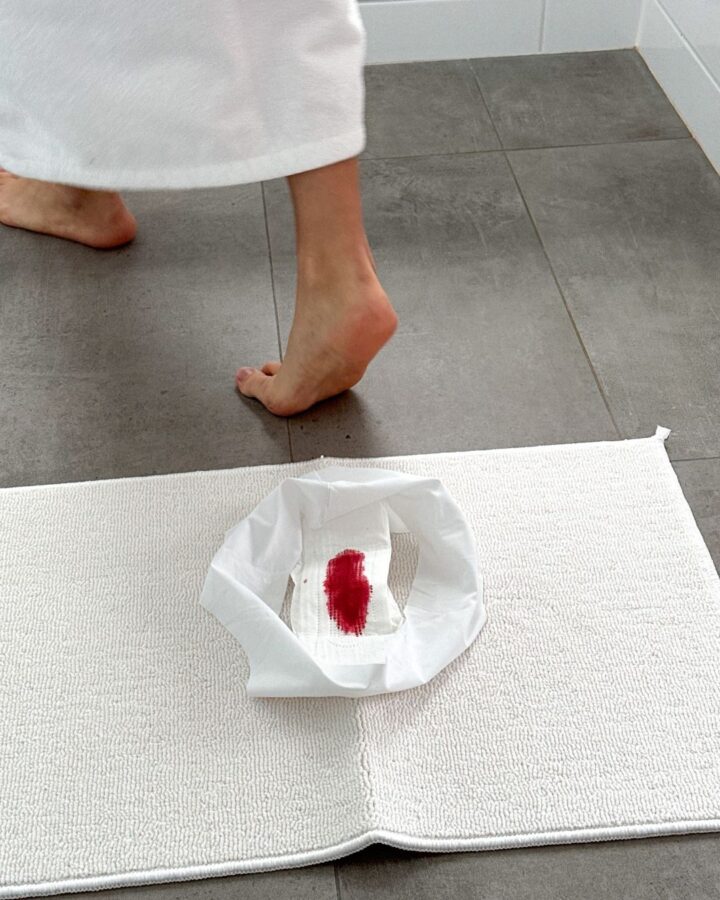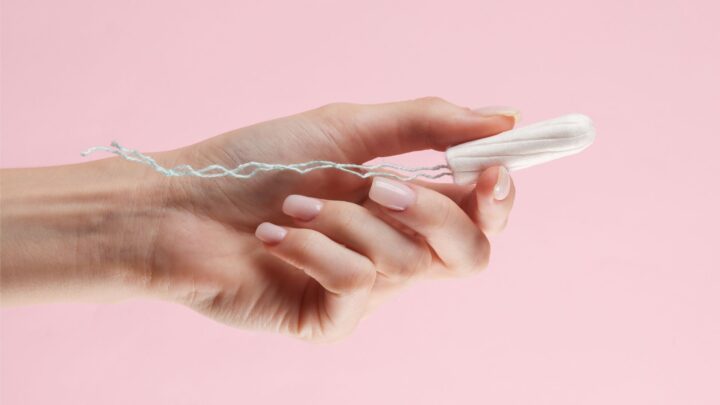
Swimming (or bathing) on your period – Everything you need to know to feel confident in the water
The information on this website is intended for general knowledge only and does not replace medical advice, diagnosis, or treatment. Herbox is not a medical institution and assumes no responsibility for how the information is used. If you have questions about your health or menstruation, always consult a doctor or healthcare provider.
Bathing on your period – myths, facts and tips
Whether you’re swimming laps, taking a bath, or just cooling off in the sea – here’s everything you need to know about going in the water on your period. In this guide, we’ll break down how to swim safely and feel comfortable in the water during your period, whether you use a tampon, pad, cup, period swimwear, or no protection at all.
However, many still have questions and concerns about it, so in this article, we will cover aspects that are good to know so you can feel safe and confident.
Swimming or bathing is often associated with relaxation and enjoyment, but for many women, questions about menstruation and swimming can cause worries and uncertainty.
- Is it possible to swim on your period?
- Is it safe to use a tampon in the water?
- Should you use a tampon or a pad?
- What risks are there really?
No need to worry! We have answers to all your questions and more.
You can swim on your period!
Let’s be honest, most of us have worried about leaks at some point. But with the right protection, you can relax and feel confident in the water. Don’t let your period stop you from doing the things you love.
Swimming while menstruating is completely safe and can even help your body feel calmer and more balanced. Periods are a natural part of life – something half the population experiences – so don’t let it stop you from doing the things you enjoy.
At Herbox, we believe your period should never stop you from doing what you love – especially something as joyful and freeing as swimming. We’re here to make periods easier, safer, and more empowering every single day.
There are many different types of menstrual products to choose from, and depending on which one you decide to use, there are a few things to keep in mind while you're in the water. But one thing that’s common for all types of menstrual products is that you need to change your product and shower after swimming for the day to ensure optimal hygiene.
Benefits of swimming on your period
Yes, you read that right. There are actually several benefits to swimming during your period. One of the benefits is that it can be incredibly relaxing and help relieve menstrual cramps. The warmth of the water can help relax the muscles and reduce cramps.
Exercising – especially swimming – also comes with benefits. Physical activity in general can help relieve menstrual pain and cramps. When you exercise, endorphins are released and blood circulation increases.
How to swim with a tampon
Swimming with a tampon is one of the most effective solutions for staying comfortable while in the water. When the tampon is properly inserted, it acts as a barrier, making it safe to swim without leaks and preventing water from entering the vagina.
The tampon sits inside the vagina, so you can't see it, which makes it a favorite for many when it comes to swimming during menstruation. Just make sure to choose a tampon that suits your flow, whether it’s light or heavy.
How long can you swim with a tampon?
Generally, you can wear a tampon for up to eight hours to avoid the risk of Toxic Shock Syndrome. When you're swimming, change your tampon every four hours to stay safe and comfortable. After your last swim, it’s also important to change your tampon immediately. And wash yourself to avoid the risk of infection.
Tips for swimming while using a tampon
- Change the tampon often, every fourth hour, especially if you have been in the water for a long time.
- Make sure the tampon is properly inserted to avoid leakage.
- Always wash your hands before putting in the tampon.
- The tampon should be comfortable and not be felt while you are using it.
Swimming while using a pad
Technically you can swim with a pad, but it’s not as effective. A pad absorbs not only menstrual blood but also pool or salt water, which can make it both uncomfortable and less effective.
Additionally, pads are attached to underwear, which is why many choose to avoid them as an option when swimming. Most women prefer to use tampons or a menstrual cup when they are going swimming.
Swim while using a menstrual cup
Swimming with a menstrual cup is a comfortable and environmentally friendly option, because it’s reusable. With the menstrual cup, you can swim and sunbathe all day, unlike a tampon which needs to be changed after swimming or every four hours if you're swimming throughout the day. The menstrual cup sits snugly against the vaginal walls, making it leak-proof and preventing any water from entering.
Think of your menstrual cup as a discreet, secure, and worry-free companion. The cup protects you from leaks and lets you swim without worry. A combination between the material and the design of the cup makes it sit in place and gives you the freedom of enjoying the swimming instead of worrying.
It’s important to remember when using a cup, to always clean it properly, according to the manufacturer's instructions. To maintain the cups' hygienic properties you should clean it after each use and always handle it with clean hands.
Period swimwear bottoms
Period swimwear is perfect if you’re not comfortable with using tampons, pads or period cups. The period bottoms simply look like regular bikini bottoms, but with built-in period protection.
They are discrete but comfortable and are a safe option to go swimming on your period with! Period bottoms should not be confused with period panties. The period panties are not recommended for swimming, because the fabric is not made of a material adapted for swimming.
Bathing and swimming without period protection
You can swim without period protection! Menstrual blood doesn’t flow into the water the way many people believe. The pressure from the water makes most of the blood stay inside the vagina. However, the blood can flow as soon as you step out of the water.
Of course, you can take a bath without protection at home, but when swimming in public places like pools or spas, it’s best to use period protection. Without protection there is a risk of leakage, which can become uncomfortable. If you are going to swim without protection, it's better to do it when your period is light.
Does swimming on your period increase infection risk?
The risk of infection does not increase when swimming on your period. It’s a common misconception, but swimming doesn’t make you more likely to get an infection.
However, you are more sensitive to getting an infection while on your period. Therefore it's important to change period protection after you have gone swimming and that you wash properly to minimize the risk for bacterial growth.
Periods and swimming in school
We know that it can feel uncomfortable to go swimming in class by itself, and it can feel even worse while on your period. Just know that you’re not alone in feeling this way – and there’s nothing to worry about.
Using period swimwear is a safe and good alternative when going swimming in PE class. They look just like regular bikini bottoms but absorb your period and prevent leaks.
The period swimwear helps a lot, but if the flow is heavy it can be good to have complimentary protection to be on the safe side. You can use a tampon or a period cup.
When you are done swimming, it’s important to clean the period bottoms. In most cases you get a moisture bag when you buy the bottoms. This is used to store your period bottoms when they are wet after using them, which prevents your bag from moisture and smell. The moisture bag absorbs the moisture from the bottoms and helps them keep dry and fresh until getting washed.
Can you go swimming in a pool on your period
Many people wonder, "can you go in the pool on your period?" The answer is absolutely yes, you can swim in a pool on your period! Just keep in mind that it can be helpful to use a tampon, period swimwear, or a menstrual cup for maximum protection and comfort, so you don't have to worry about leaks. Swimming in a pool while on your period is nothing you need to worry about!
Can chlorine affect your period cycle?
Swimming in chlorinated water during menstruation does not affect your menstrual cycle. However, chlorine in the pool water can irritate sensitive skin and mucous membranes. It can worsen any skin irritation that may occur during menstruation.
To reduce the risk of skin irritation, it's a good idea to shower both before and after swimming in chlorinated water to wash off the chlorine and other chemicals from your skin. It may also be helpful to apply a moisturizing cream to hydrate the skin and reduce dryness and irritation.
Can you take a bath on your period?
You can bathe in a bathtub during your period. You can use a menstrual cup, tampon, or pad if you want, but it’s just as fine not to use any period protection at all. Menstrual blood will not stain the water or leave any traces while you're in the water. When you stand up, it may flow out and end up in the water, but so what?
Can you swim in the ocean on your period?
Absolutely, you can swim in the ocean while on your period! Many women choose to continue with their usual water activities during their period. Swimming in the sea can be both refreshing and relaxing.
To make it as comfortable as possible, it may be a good idea to use period protection while swimming in the sea, especially if you want to avoid leaks. Remember to bring extra protection, as it's important to change your protection after you finish swimming for the day, no matter which type you use.
Can swimming trigger your period?
Swimming does not make your period start. The menstrual cycle is controlled by other factors like hormones and is not directly affected by activities you do. Of course, your period can start while you're swimming, but it’s probably not because of the swimming itself, but simply because it was time.
Is the period going to flow when I step out of the water?
When you swim and are in the water, the pressure from the water creates an effect that often prevents menstrual blood from flowing out. However, when you get out of the water, especially if you stand up, the blood may start to flow again.
Most of the time, it's not large amounts of blood, but we recommend swimming with appropriate period protection like a tampon, menstrual cup, or period swimwear if you want to avoid that when you get out of the water.
Menstrual stains on swimwear
When it comes to menstrual stains on swimwear, it can be a frustrating experience, but trust us you are not alone in that feeling. We can almost guarantee that every woman has experienced a menstrual stain on her underwear or swimwear at some point in her life.
There are ways to handle menstrual stains effectively. Using period protection reduces the risk of leaks, but if the incident has already occurred, you should rinse the swimwear in cold water as quickly as possible to prevent the stain from setting.
Then, use a mild soap solution to treat the stain before washing them as usual. Remember, menstrual stains are completely natural and absolutely nothing to be ashamed of!
Final thoughts: Swim without worries on your period
The conclusion is that you can absolutely swim during your period, and there’s nothing stopping you from enjoying your time in the water. With the right protection and some simple precautions, you can feel safe and comfortable swimming during your menstruation.
We want women to feel confident and safe in all situations, both above and below the surface. Whether you’re swimming during your period, taking a relaxing bath, or just going for a dip – you can absolutely feel comfortable in the water.. With the right products and a few simple tips, you can move freely, feel comfortable, and enjoy every splash. Tips, myths & how to stay confident by Herbox

Ready to get started?
Contact us for a quote, demo or just a little more info.
Fill in the form and we'll get back to you within 24 hours - and show you how Herbox can work for you.
Read similar articles
